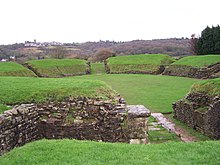Theatre of Wales


Theatre in Wales includes dramatic works in both the Welsh language and English language. Actors from Wales have also achieved international recognition.
History

Middle Ages
The earliest known performance tradition is that of the
suggests that drama may well have been introduced during the classical period.Drama in Wales as a literary tradition dates to
Modern era
The development of Renaissance theatre in England did not have great influence in Wales, as the gentry found different forms of artistic patronage. One surviving example of Welsh literary drama is Troelus a Chresyd, an anonymous adaptation from poems by Henrysoun and Chaucer dating to around 1600. With no urban centres to compare to England to support regular stages, morality plays and interludes continued to circulate in inn-yard theatres and fairs, supplemented by visiting troupes performing English repertoire.[1]
Stock Welsh characters occur in theatre in England on the Tudor and Stuart stage.
Twm o'r Nant (1739–1810) was famous for his anterliwtau (interludes), performed mainly around his native Denbighshire. The bawdiness and licensed foolery of the comic stereotypes of the interlude tradition have been compared to commedia dell'arte. However the religious revival connected with the rise of Methodism in Wales brought an end to such libertine satires. Interludes came to be replaced as expressions of public drama by a high-flown and imagistic preaching style and dialogues on moral issues such as temperance.[1]
The English classical repertoire was brought to those who could understand it by travelling troupes such as the Kemble family (Charles Kemble was born at Brecon in 1775).[1]
Into the 20th century
In the late 19th century and early 20th century, Welsh literature began to reflect the way the Welsh language was increasingly becoming a political symbol. Secular drama began to attract interest in the 1870s as national consciousness grew. Plays in a Shakespearean style were written, such as Beriah Gwynfe Evans' patriotic play Owain Glyndŵr, performed at the Llanberis Eisteddfod of 1879.[1]
There was institutional opposition to the new drama. The Methodist Convention in 1887 recommended that chapels regard theatrical activity as an immoral practice on a par with gambling. It was not until 1902 when David Lloyd George called for patronage of Welsh drama at the National Eisteddfod that drama started to be respectable among devout communities.[1]
With the advance of the English language, theatre in English developed quickly between 1875 and 1925. By 1912 Wales had 34 theatres and many halls licensed for dramatic performances. However, the arrival of sound cinema in the 1930s led to the closure or transformation of most theatres.[1]
A full theatre tradition only developed in Wales with 20th century Welsh drama. Many playwrights were inspired by the example of the
Inter-war period
The inter-war period has been described as a golden age of amateur dramatics, with five hundred companies active all over Wales providing a second occupation for large numbers of quarrymen and miners. This flourishing tradition was curtailed by the outbreak of the Second World War and ended by the arrival of television in the 1950s.[1]
Saunders Lewis (1893–1985) was above all a dramatist. His earliest published play was Blodeuwedd (The woman of flowers) (1923–25, revised 1948). Other notable plays include Buchedd Garmon (The life of Germanus) (radio play, 1936) and several others after the war. Siwan (1956) together with Blodeuwedd are considered as the "canonical examples of Welsh language drama"[3] He also translated Samuel Beckett's En attendant Godot into Welsh.
Post war
Professional theatre developed in Wales in the 1950s and 1960s.[1]
Cynan (
21st Century
Wales has two national theatres: Theatr Genedlaethol Cymru (the Welsh language national theatre of Wales, founded 2003), and National Theatre Wales (the English language national theatre company of Wales, founded 2009). Theatr Genedlaethol Cymru attempts to shape a distinctive identity for drama in Welsh while also opening it up to outside linguistic and dramatic influences.[7]
Modern theatre in Wales is recorded on the website www.theatre-wales.co.uk, an archive of 4600 reviews and articles.[8]
See also
References
- ^ ISBN 0708313833.
- JSTOR 2914981.
- ^ Lloyd Llewellyn-Jones, Trasiedi Gymraeg: Is there a Classical Tradition in Welsh Language Drama?
- ^ Dylan Thomas: The Collected Letters edited by Paul Ferris. Macmillan 1985. Footnote by editor.
- ^ Green Man Review, "Dylan Thomas Unabridged: The Caedmon Collection""Dylan Thomas Unabridged: The Caedmon Collection [audio]". Archived from the original on 2014-08-30. Retrieved 2013-06-26.
- ^ Prix Italia "PAST EDITIONS — WINNERS 1949 - 2007" Archived 2012-03-03 at the Wayback Machine
- ^ Gardner, Lyn (1 September 2011). "Has Welsh theatre found its voice?". The Guardian. Retrieved 4 November 2012.
- ^ http://www.theatre-wales.co.uk/index.asp. "Review of National Theatre: Comment from the theatre dance and drama in Wales web site". www.theatre-wales.co.uk. Retrieved 2023-01-15.
{{cite web}}: External link in|last=
